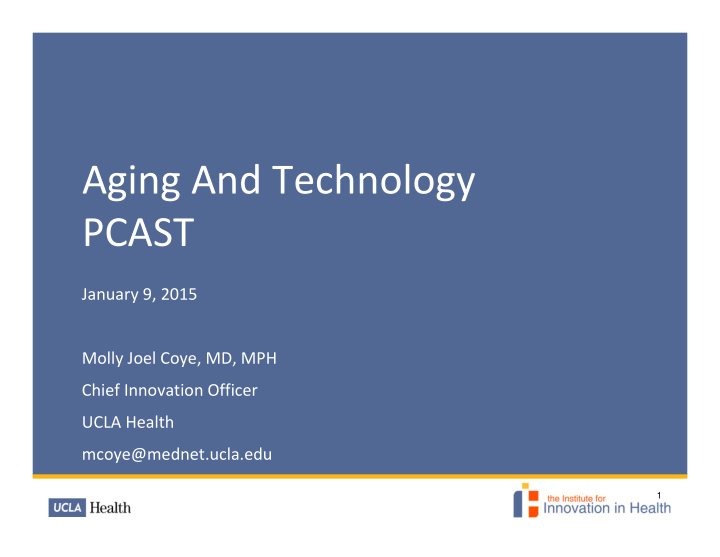



Aging And Technology PCAST January 9, 2015 Molly Joel Coye, MD, MPH Chief Innovation Officer UCLA Health mcoye@mednet.ucla.edu 1
2
Three Key Observations 1. We suffer from a disproportionate focus on medical innovations Virtual Visits MGH Beacon Hill
CONNECTED AGING TECHNOLOGIES Cloud & Sensors & Platform Telehealth Novel sensing devices technologies and Services services for for physiology, remote delivery of activity and location health care Data & Analytics Predictive analytics, Technologies and quantified self, Mobile, Apps motivational strategies to internet of things, engage consumers in public & Gaming decision support and personal health
WHAT’S NEXT IN THE IMMEDIATE FUTURE? New World of Connected Health and Aging EMR Connected Medical Assistive Technologie Devices External Sensors Smart for Remote Medication Monitoring Management Fall Prevention Remote Lab Patient/Provider/Ca regiver Communication Platform Robots Local Social Commerce Smart Body Networks sensors Health & Big Data Social Apps and AI
Three Key Observations 1. We suffer from a disproportionate focus on medical innovations 2. Providers are a barrier to the distribution of most effective technologies and services And reimbursement models
Three Key Observations 1. We suffer from a disproportionate focus on medical innovations 2. Providers are a barrier to the distribution of most effective technologies and services 3. It’s not just the technology – service models and business models are also required
Kaiser Permanente In ‐ Home Palliative Care Program IHPC parallels the Medicare Hospice benefit with important modifications Care is not limited to the last six months of life – • Would you be surprised if your patient died in the next 12 months? Enrollment does not require forgoing curative care • Services are a blended model, gradually decreasing curative practices and increasing • palliative measures Services are provided in the home Most services are provided by nurses and clinical social workers • Physician home visits as needed • Studies conducted within KP found that this model: Reduces both emergency room visits and hospitalizations • Produces cost savings ranging from 37% to 45% less than terminally ill patients • receiving traditional care Improves patient satisfaction in short and mid ‐ term •
Recommend
More recommend